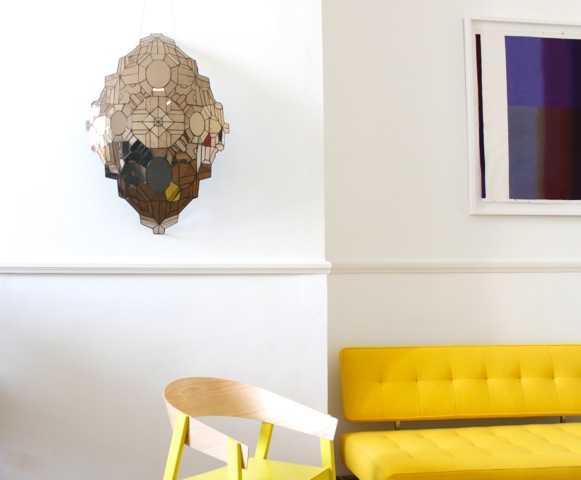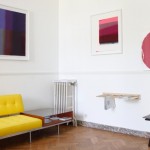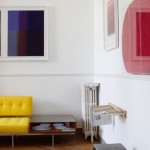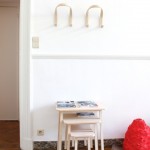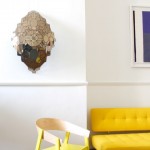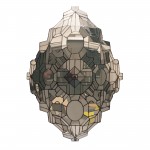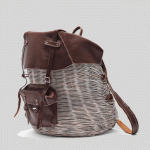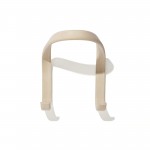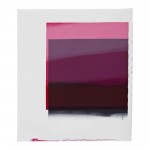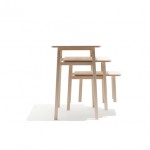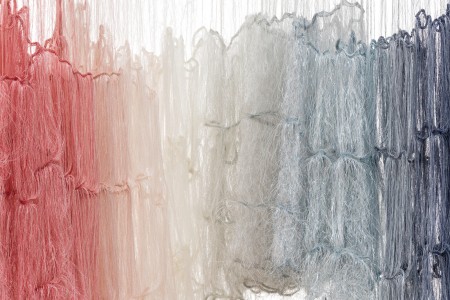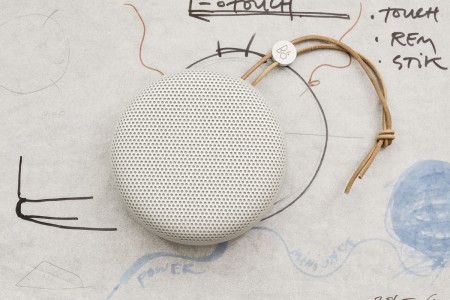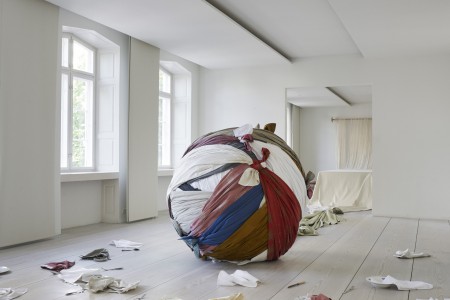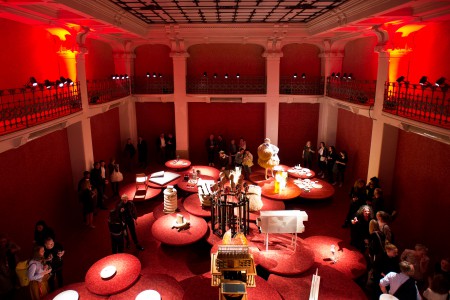Mindcraft 2012 selection at Ampersand House & Gallery from 2 June with tl.mag
tl.mag have selected together with Ampersand House & Gallery a series of emerging talents from Danish Crafts‘ MINDCRAFT12 exhibition that was shown in Milan in April in the emerging and alternative Zona Ventura Lambrate. This show MINDCRAFT12 has been curated by the renown designer Cecilie Manz.
Among the outstanding selection, you will find the post revival Dandy Mirror by benandsebastian (Ben Clement og Sebastian de la Cour), Anne Fabricius Møller, Louise Campbell new lighting designs, Henrik Vibskov’s fashionable picnic bag, Georg stool in wood with a grey felt cushion by Christina Liljenberg Halstrøm, Line Depping hooks, Tora Urup glassware, Louise Sass colorful installation based on textile, Peter Johansen and Thomas Bentzen‘s furnitures and Jakob Jørgensen library wood set.
The eleven works from MINDCRAFT12 that are exhibited are the mirror The Dandies by benandsebastian, the chair Ash by Thomas Bentzen, the paper lamp Papercuts by Louise Campbell, the coat Hook by Line Depping, the textile work In Your Big Sunny Window by Anne Fabricius Møller, the nested tables All Good Things Come in Threes by Peter Johansen, the bookcase Poet’s Book Hangerby Jakob Jørgensen, the stool Georg by Christina Liljenberg Halstrøm, the textile friezes Pink Elephants & In the Dark by Louise Sass, the glass series Tumblers and Plates by Tora Urup and the picnic basket Suitnest Dining by Henrik Vibskov.
The Dandies
“The dandy [is] an actor playing himself […] He observes his image in order to modify it.” Sabine Melchior-Bonnet
benandsebastian drew inspiration for ‘The Dandies’ from historical, pre-modern mirror-making techniques. They work in the borderland between design, art and architecture. With their contribution to MINDCRAFT12 they have aimed to create a project that operates on multiple levels: as a design object, as an image and as a spatial installation that reflects, distorts and reshapes its context. The Dandies are optical mirrors. The Dandies are material mirrors. The Dandies are conceptual mirrors
Suitnest Dinner
Suitnest Dinner is an ingenious bag. The bag was made using basket work, leather craft and an apparently free flow of associations on the notions of ‘open-air dining’ and ‘picnic wear’. Suitnest Dinner is the whole package – suit, tie, fork, knives and leather straps for carrying the whole thing on one’s back. With Suitnest Dinner, Vibskov addresses the exhibition title ‘Mindcraft’ directly, inviting reflections on fashion, design and craft.
Fashion designer Henrik Vibskov’s drive is combined with an ambition of creating exciting experiences for the beholder. The meeting between product and beholder gives rise to a synergy that fosters new mindsets and approaches to everyday life. Vibskov’s exhibition venues include MoMA PS1 in 2007, Palais de Tokyo in 2005, Zeeuws Museum in 2009, Wilhelm Wagenfeld Haus in 2010 and Nederlands Architectuurinstitut Rotterdam (NAi) in 2010. He received Grundfos Travelling Scholarship Talent Award in 2007, an award from the Danish Arts Agency in 2009 and, most recently, Thorsten and Wanja Søderberg’s award in 2011. His universes include installations based on wood, fabric, plants, bicycles and other props used to convey the visions behind his designs. “The Solar Donkey Experiment” and “The Fantabulous Bicycle Music Factory” – the titles of Vibskov’s fashion shows give an impression of the flight of imagination that inspires these universes.
Pink Elephants and In the Dark
Since 2008, Louise Sass has explored, developed and systematised a special method for mixing colours directly on textile. This process also forms the basis for Pink Elephants and In the Dark, creating the interplay between the colours and the curves and folds of the textile. Both products are one-offs, made with reactive dye that is hand-printed on cotton textile that is subsequently dyed with water-soluble transparent dyes. The thread adds texture to the textile and conditions the reproduction of the colour on the fabric. The method has its inherent limitations, but the limits can be challenged, and the process is evident in the resulting work. During a stay in Japan Louise Sass learned about the significance of the gap as a dynamic spatial factor. As a result, the dialogue with colour and the interplay between overlaps and displacements in gaps form the basis of her work today – as exemplified in the intriguing works Pink Elefants and In the Dark.
Georg
Georg is a four-legged ash wood stool with a cushion made of grey wool and kapok. The cushion is very simple with internal kapok padding and leather lace to keep it in place.
All the components of the stool are visible, and their function takes priority over their otherwise aesthetic and decorative appearance. Liljenberg aims to make objects that the user wants to touch. As expressed in Georg, this is something she pursues by a variety of means, for example in her choice of materials: carefully crafted wood, soft wool. She also made the cushion wider than the seat in one dimension in the hope that this will encourage people to pick up the cushion and examine the piece more closely. The stool was named after Liljenberg’s oldest son, who often keeps her company in the workshop.
Poet’s Book Hanger
Jakob Jørgensen’s contribution to MINDCRAFT12 deals with the storage of books. The work, Poet’s Book Hanger, consists of several book ‘sticks’, which can be used both as bookmarks and as a means of ‘hanging’ the books on the wall. The book sticks can be wedged in between two mouldings mounted on the wall. In addition to the book sticks the piece features a book shelf, which is similarly mounted by means of the two mouldings.
With Poet’s Book Hanger Jakob Jørgensen experiments playfully with the functional aspects of book storage in a search for an alternative to the classic book case.
The work was made with standard wood working techniques involving a plane, a saw and a milling template.
In Your Big Sunny Window
With ‘In Your Big Sunny Window’, Anne Fabricius Møller has created what she calls ‘art-in-progress’. The idea is that the large acrylic case should not be opened until its owner decides to prise it open. For the best result, Anne Fabricius Møller recommends that the box stay closed for 12 years. After 12 years, the case will reveal a 30-metre length of linen/cotton fabric which will show the signs of fading and the little textile comments left behind by the effects of the light. Before the fabric is placed into the case, it is pinned and rolled up like a rolled joint. This produces parallel wavy lines and a pattern structure resembling a landscape, with the displacements that occur when too much textile is crammed into a small space.
The idea behind this work, says Anne Fabricius Møller, is to mimic a curtain drawn aside that fades in stripes over the years. After a process involving the effects of light and time, the result is a length of fabric with faded stripes.
Papercuts
Papercuts is a series of lamps made in paper; and is the fruit of a collaboration with Louis Poulsen Lighting, a company that Louise Campbell has cooperated with on several previous occasions.
Sometimes it is worthwhile to stop up and take a close look at a project at an earlier stage than originally planned. I had intended for these lamps to be made in laser cut steel and textile, but during the process of model making, the many delicate qualities of the paper at hand outshone my original intensions. Commercially, paper for this project is far from ideal. It offers too many practical problems. Cleaning, for one. But look at the light and the shadows. Because the material is delicate, so is the light. For Mindcraft, where fragility is permitted, I have therefore decided to let them be at this stage of innocence.
Where Louis Poulsen and I take them from here in order for them to be suitable for the production line, is another chapter.
Ash
Thomas Bentzen’s contribution to MINDCRAFT12 is a personal, nerdy experiment where he attempts to minimise the use of materials and tools. The seat and back of the chair are made in the lightest and thinnest veneer possible, and instead of moulding the chair, Thomas Bentzen bent the seat and back by hand and glued them onto the frame. The solid ash wood frame is assembled with dowels.
Thomas Bentzen explains that he prefers wood to other materials because he finds it ‘less hot and more pleasant.’
Hook
Line Depping’s contribution to MINDCRAFT12 is a large wooden coat hook. She drew inspiration from bentwood furniture and other coat hooks in steam-bent wood.
The hook is large and is intended for a casually discarded jacket or for a hanger with freshly ironed clothes. Thus, the hook accommodates the casual as well as the neat and tidy.
Tumblers & Plates
Tora Urup contributes to MINDCRAFT12 with a series of tumblers and plates. The glasses are made in thick clear glass, the plates in clear and opaline coloured glass.
The pieces are made in a centrifugal process, where the glass is spun into its shape. This technique produces an expression where the thick glass takes on a round and optical character. The optical effect is apparent when colours are reflected in the clear glass.
The round character is accentuated by the rounded rim of the tumbler, which is soft and pleasant to drink from; a detail that is a natural result of the production process.
With this series, Tora Urup aimed to create glasses and plates with a design that enhances the experience of the material and a series that inspires and invites to serving and enjoying food and drink.
Discover Mindcraft 2012’s selection from 2 June until 7 July 2012 at Ampersand House and Gallery organised with Danish Crafts and TL MAGAZINE
